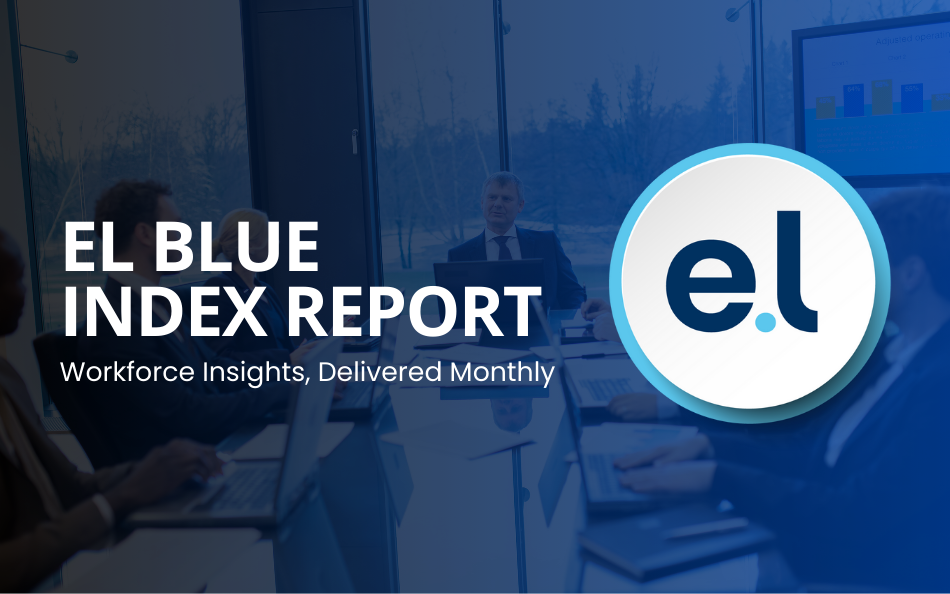Up two percent one month down two percent the next.
Executive jobs in Australia treads water as national trends diverge across states
Australia’s executive job market showed little clear direction in August with modest gains in Finance and Marketing offset by weaken demand in Management roles
The EL Executive Demand Index, published by leading human resources consulting firm E.L Consult rose 2 per cent nationally in August — A modest uptick that continues the employment markets “zig-zag” pattern of recent months.
“The stock market is at record highs and continues to add a positive feel in the minds of business managers” said Grant Montgomery, Managing Director of E.L Consult, “ But new employment laws in Australia, US tariff shenanigans and ongoing international conflicts are creating uncertainty –particularly for large employers reliant on open trade.
Since Covid Mr Montgomery noted that while the 2 percent gain was positive, there was no sustainable upward trend developing. “Consumers remain cautious and that is flowing through to business hiring producing monthly swings of a few percentage points with no clear direction” He said.
State-by-State Performance
Queensland is thriving and led the way with a 7 percent rise in executive demand in August, continuing a steady recovery that has being building since COVID lockdowns and the poor economic management of the previous government. The state is steadily closing the gap on Victoria, though it remains in third place behind New South Wales and Victoria.
Victoria, by contrast, continues to struggle and despite strong population growth, its share of national economic output has slipped to 22.7%. Per-capita output is in decline, and executive demand remains subdued. Mr Montgomery suggested that policy settings — including proposals around mandated work-from-home arrangements and four-day work weeks — may be discouraging business activity.
The ACT remained buoyant, supported by the un-paralleled public service expansion.
Western Australia and South Australia recorded slight declines.
Sector Trends
Marketing and Information Technology were the biggest performers in August.
Marketing has been the strongest sector over the past 12 months, while IT, despite August’s gains, remains on a negative long-term trend.
Management was the only sector to contract, down 7 percent for the month.
Outlook
Mr Montgomery said Queensland’s growth highlighted a sharp contrast with Victoria. “Queensland has been able to convert its population gains into economic activity, even though per-capita measures have softened. Victoria, by contrast, is battling a services and housing slowdown and not retaining business confidence,” he said.
“With no clear national trend emerging, the executive job market remains delicately balanced —waiting for stronger consumer demand, more stable policy settings and clearer global trade environment to drive sustainable growth.”
Call Grant Montgomery on +612 9221 6688 or 0414926688 for further details
August 2025 Statistics
August 2025 National Index
August 2025 National Index: 480
Same period last year (August 2024): 552
Percentage change over last month: 2%
National Summary
The executive job market has continued to tread water in August as further gains in the Finance and Marketing sectors are offset by an anaemic performance from the Management sector. The EL Index rose 2 per cent overall in August as executive demand struggled to make new trends amid headwinds of troubled consumer demand and high relative interest rates.

National Demand for Executives Over Last Seven Years
The executive demand long-term trend is being positively affected by two months of consecutive increases. However, the long-term trend continues to remain close to a post-Covid low.


State by State Comparison
Queensland continues to stalk Victoria as the second-biggest supplier of executive positions (New South Wales has increased its lead since Covid). However, in August most states and territories rose, led by Queensland and the ACT. Western Australia and South Australia produced mild losses.

Executive Groups
The Marketing and Information Technology areas recorded strong gains. IT continues to show a negative overall trend, while Marketing is the best-performing sector over the past 12 months. Management was the only sector with a a negative result – down 7 per cent.
August 2025 E.L Finance Index
August 2025 E.L Finance Index: 788
Same period last year (August 2024): 806
Percentage change over last month: 1%
The Financial index rose 1 per cent in August and continues to struggle to make any headway.
The gains and losses were fairly spread, with the large states of Victoria and New South Wales were relatively broad across the regions, with only Tasmania recording a negative result.
The ACT continues to perform strongly in this space, underpinned by thriving property/ construction markets that in their turn are underpinned by rising government employment trends. Other regions to gain include New South Wales and Western Australia.


August 2025 E.L Engineering Index
August 2025 E.L Engineering Index: 214
Same period last year (August 2024): 263
Percentage change over last month: 4%
Engineering performed in the middle of the pack in August falling 4 per cent, and over the medium term is struggling to break out of its mildly negative trend.
It is troubling that Engineering continues to give up ground as Engineering-related projects open the way for future growth (as long as the projects such as infrastructure are based on relatively proven and stable economics, and not political whims). Without Engineers guiding engineering projects there can be a tunnel that can put strictures on other growth-related initiatives required to drive sustainable cost of living improvements.
Victoria and Queensland moved forward while the smaller regions of the Northern Territory and the ACT were negative.


August 2025 E.L Management Index
August 2025 E.L Management Index: 620
Same period last year (August 2024): 819
Percentage change over last month: -7%
The Management sector recorded a 7 per cent fall in August, continuing the falls seen throughout most of this year.
After the unlikely flick up in September last year, Management has fallen in most months. The falls have not been extensive, but mouldering – in fact, continuing the longer term trend from way back in 2022.
Although it is difficult to nominate why Management is in a troubled state, it could be postulated that there was a build up of Management during Covid that was unsustainable, and since then there has been a natural downturn as companies recognised the real ongoing executive-level requirements.


August 2025 E.L Information Technology Index
August 2025 E.L Information Technology Index: 150
Same period last year (August 2024): 233
Percentage change over last month: 16%
Information Technology was the equal strongest sector in August, rising 16 per cent compared to the prior month.
However, this could be labelled the equivalent of a “dead cat bounce”, with IT having fallen sharply since 2021. In fact, since 2021 IT demand has virtually halved.
Given that AI is meant to be business’s great productivity hope, it seems unusual that IT demand has continued to fall. Anecdotal evidence is that the relative ease of utilising IT now could be seeing IT-specific jobs folded into broader business activities rather than being discrete positions.


August 2025 E.L Marketing Index
August 2025 E.L Marketing Index: 585
Same period last year (August 2024): 526
Percentage change over last month: 16%
Marketing was again a strong performer, rising 16 per cent to be the equal best gainer for the month.
Marketing has been the best-performing index since Covid, assisted by strong government sector demand across the country, but particularly in the ACT and New South Wales. There is a feedback loop here – the more Marketing executives on the government side lead to them being met by more Marketing executives on the business sector side who have been hired to deal with/ lobby them.


About the E.L Index
The E.L Index is a comprehensive monthly analysis of employment trends at executive level. An Australian analysis is produced in Sydney and an Asian analysis in Hong Kong and Singapore.
The E.L Index has shown by two separate University studies to correlate strongly with general economic and business trends. It is featured by most of the major news services and is closely followed by government and central bank analysts.
The E.L Index is actually a combined national index of all executive demand made up of five separate indices; E.L Finance Index, E.L IT Index, E.L Management Index, E.L Marketing Index and the E.L Engineering Index.
The National and specific career group Indexes are shown as relative indexes recording the monthly demand activity for executive positions in the current month against the demand in a historical base period which is normalised to 100. The historical base period used was the average of the last quarter of 1992 which research showed to be the bottom of that downturn.
By averaging to a historical base period the comparison of, say, June 1994 to June 2000 is meaningful, giving a clean, easily understood appreciation of changing investment and economic trends without seasonal obscurity.
The E.L Index utilises data from both print and internet sources and is the only employment index to do so.
The print data is collected from the major employment paper in each state. National papers are not used to avoid “doubling up”. Internet data is not collected off the web sites which can be subject to some error but instead collected through raw data provided by the ISP themselves. Print data has over 15 years of historical data and the internet more than 6 years.
Why Executive Demand is a Primary Lead Indicator?
It is often claimed that unemployment figures and broad-based job vacancy surveys do not give a fair impression of what is occurring in executive ranks. The E.L Index addresses this and has some interesting correlative and predictive qualities. Such as:
- Employment of management usually precedes the employment of skilled and unskilled workers.
- Employment of engineering executives precedes major capital investment.
- The division between various management sectors gives an indication of which sectors of the economy are experiencing growth or decline.
- Compares month by month changes in the public and private sector as well as monitoring government expenditure patterns.
- Makes regional comparisons after allowing for population differences.
- It shows a ‘rate of change’ and can therefore be realistically compared to general economic and employment growth unlike some surveys that report absolute numbers.
- Core data is collected on an actual expenditure of business and government, not on a respondent’s opinion or confidence level.


